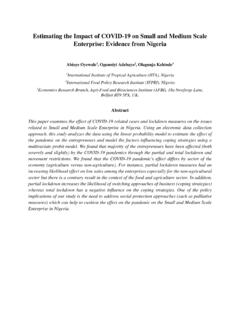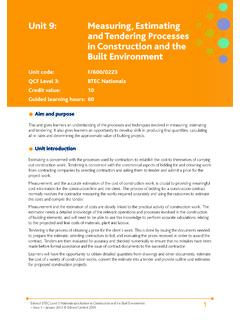Transcription of Common types of clinical trial design, study objectives ...
1 Common types of clinical trial design, study objectives , randomisation and blinding, hypothesis testing, p-values and confidence intervals, sample size calculation David Brown Statistics Statistics looks at design and analysis Our exercise noted an example of a flawed design (single sample, uncontrolled, biased population selection, regression to the mean) And statistical theory can be used to understand the reason for the results Not a completely outrageous example Case study Primary endpoint recurrence rate post-treatment compared with historical rates observed 1-year pre-treatment Inclusion criteria include requirement that patient must have been treated for uveitis within the last 3 months Results Same problems here Uncontrolled blood pressure trial could be similar inclusion criteria usually require a high value Recurrence rates (n=110) (n=168) pre-implantation (1-year) 68 (62%) 98 (58%) 34 weeks 2 (2%) 8 (5%) 1- year 4 (4%) 11 (7%) 2- years 11 (10%) 28 (17%) 3- years 33 (30%) 80 (48%)
2 clinical Trials Prospective experiments in medical treatments Designed to test a hypothesis about a treatment Testing of new drugs Testing old drugs in new indications Testing of new procedures Comparison of randomised groups Contrast to Epidemiology clinical trial Groups differ only by intervention of interest Patients allocated to treatment, do not choose it Epidemiology Treatment groups contain confounding factors smoking and cancer patients have decided to smoke (not been allocated) smokers tend to drink more coffee cannot untangle confounding in a trial Design of clinical Trials Define the question to be answered New drug better than placebo New drug plus standard better than standard alone New drug better / no worse than a licensed drug Patient population Posology (treatment schedule) Outcome measure Define success Ideal clinical trial Randomised Double-blind Controlled (concurrent controls)
3 Pre-specification Everything pre-specified in the protocol Analysis pre-specified in the data analysis plan Avoids problems of multiplicity and post-hoc analysis There are always problems if people are free to choose anything after the data are unblinded Controls What will the experimental treatment be compared to? Placebo control Active control Uncontrolled Historical control Concurrent controls are ideal Problems with uncontrolled trials 100 subjects treated, 80 got better, therefore treatment is 80% effective Regression to the mean Placebo effect / study effect Case study Treatment for depression Drugs with no efficacy can seem impressive in uncontrolled trials Active (n=101) Placebo (n=102) Active - Placebo (CI) p- value Baseline score Change to Week 8 + ( , ) p= Problems with historical controls 100 subjects treated, 80 got better.
4 This disease was studied in 1994 and in a sample of 100, 50 got better. So the new treatment is 30% better than the standard Patients may differ May be generally healthier - more time at the gym Treatment may differ - doctors more experienced with the disease Evaluation may differ - definition of got better Randomisation Allocation of subjects to treatment or control Avoiding bias Subjective assignment can be biased Compassion - sicker patients on active Enthusiast - Likely responders on treatment Systematic (by name, age etc.) can be biased Lead to imbalance - patients entered based on treatment allocation Randomise after patient has been accepted for trial Simple Randomisation A list is generated Each row independently randomised Unpredictable Could be unbalanced Blocked Randomisation List generated in balanced blocks block size 4 ABBA, BABA block size 8 ABAAABBA, AAABBBBA Small block size - balanced but more predictable Large block size - less predictable but possible imbalance Stratified Randomisation Randomise within each strata separate list for males and females separate lists for older males, younger males, older females.
5 Younger females Problematic with large number of important factors Less necessary in large trials Not essential for subgroup analyses to be done Useful if want to ensure balance for a few important factors Minimisation / dynamic allocation Favours allocation to the group which minimises the imbalance across a range of characteristics sex, age, country Allocate with certainty, or with a probability > Not recommended in guideline - properties not well understood - costly mistakes can be made! Only use if really necessary Blinding Double-blind Patient and investigator blind Single-blind Patient blind Open Blinded independent review Why blind?
6 Avoiding bias Why blind patients? Patients expectations can influence response Might report more adverse events if known to be on treatment Might assume no efficacy if on placebo Why blind investigators? May subconsciously influence outcome measures Some endpoints controlled by investigators and could be influenced by knowledge of treatment How is blinding done? Test vs. Placebo Make placebo identical to active Test vs. Active Make both treatments identical OR construct placebo for each (double dummy) Difficult to blind Trials involving surgery Sham operations present ethical difficulties Trials of interventions such as massage or psychotherapy Impossible to blind (but can at least make assessors blind) trial design - Parallel Group trials Patients are each randomised to ONE of the treatment arms The results from the 2 (or more)
7 Groups are compared at the end of the trial Crossover trials Patients initially randomised to one of the treatment then cross-over to the other treatment Washout between treatment periods Difference between treatments for each patient considered adjusting for period effect Crossover trials Advantages Fewer patients needed Eliminates between patient variability Test is Within-patient Disadvantages Carry-over effects possible Can t be used in curable diseases or for long-term treatment Data wasted when patients drop-out in first period Duration of trial (for each patient) longer Sample size calculations Give an approximate idea of the number of patients needed to give a good chance of detecting the expected effect size Linked to the analysis (or significance test) that will be carried out at the end of the trial The calculation requires.
8 Treatment effect of interest Estimated variability Desired Power Required significance level Sample size calculations Sample size can never be agreed More subjects included more chance of effect (if it exists) being detected Treatment Effect A treatment advantage of clinical interest If the treatment has this effect it is worth developing Large effect = small sample size Variance General variability of the endpoint being measured Can reduce variability with good trial design Large variance = large sample size Significance level The significance level that the final analysis will be conducted at Also known as Type I error Also known as consumer s risk Also known as alpha The probability that an ineffective treatment will be declared to be effective Normally fixed at (5%)
9 Low Type I error = high sample size Power The probability of the study to detect the difference of interest (if the treatment really does have the expected effect) Also known as 1 minus the Type II error Type II error is the probability that an effective treatment will be declared to be ineffective Type II error also known as producer s risk Common values for power 80% and 90% High power = High sample size Analysis and interpretation Hypothesis testing P-values Confidence intervals Interpretation Replication How statistics works We can t always measure everyone! Sampling is the selection of individual observations intended to yield some knowledge about a population of concern for the purposes of statistical inference.
10 This gives estimate plus associated error When we measure a quantity in a large number of individuals we call the pattern of values obtained a distribution. Calculate mean, median, mode, variability and standard deviation: 1, 2, 2, 2, 4, 4, 6 Mean = Mode = Median = Variance = Standard Deviation = Calculate mean, median, mode, variability and standard deviation: 1, 2, 2, 2, 4, 4, 6 Mean = 3 Mode = 2 Median = 2 Variance = 18/7 or 18/6 (18 from (-2)2+3 ( -1)2+2 12+32) Standard Deviation = sqrt VAR The normal distribution Symmetrical, Mean = Median = Mode Mean 2 x sd covers most of distribution Many examples.
















